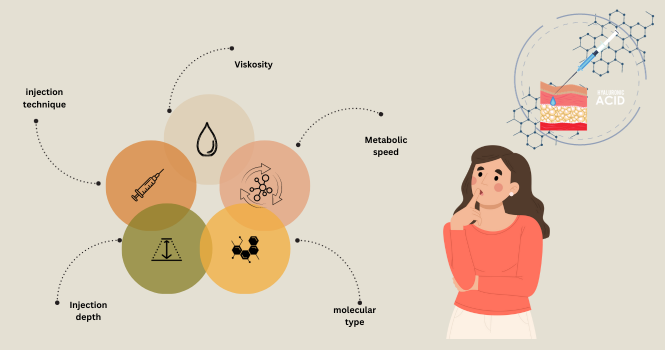
Which Hyaluronic Acid Lasts the Longest? An Overview of Different Types and Their Durability
The Importance of Hyaluronic Acid Treatments in Aesthetic Medicine
Hyaluronic acid injections play a vital role in aesthetic medicine. They are used to:
- Enhance or shape the lips
- Reduce age-related wrinkles
- Tighten the face and improve facial contour
Hyaluronic acid is a natural substance produced by the body, responsible for skin hydration and elasticity. Over time, the amount of hyaluronic acid in the skin decreases, leading to wrinkles and sagging skin. With hyaluronic acid injections, this breakdown can be countered. Deep wrinkles are softened, facial contours are improved, and the skin becomes firmer. Hyaluronic acid can also be used to add volume to the lips and cheeks.
Hyaluronic acid is a safe and effective way to provide the skin with the necessary moisture and elasticity, protecting it from the aging process. Since hyaluronic acid is a natural component of the skin, it is highly compatible, with minimal risk of allergic reactions.
Which Type of Hyaluronic Acid Provides Long-Lasting Results?
Generally speaking, the higher the viscosity or molecular weight of the hyaluronic acid, the longer the results last.
Hyaluronic acid fillers with lower viscosity typically last 5 to 7 months. With higher viscosity, the effect can last up to 9–12 months.
Hyaluronic acid is gradually broken down by the body. Larger molecules take longer to break down, extending the longevity of the effect.
Hyaluronic acid is also used in cosmetics like creams, serums, and peels. It’s a natural moisturizer that smooths the skin and has antioxidant properties, helping combat inflammation. When combined with other ingredients, it can stimulate collagen production and increase skin elasticity.
However, it’s important to note that hyaluronic acid can only be absorbed by the skin through injections. Therefore, hyaluronic acid fillers are much more effective than regular creams.
What Influences the Durability of Hyaluronic Acid?
Molecular Crosslinking
The crosslinking of a molecule refers to how many bonds it has. The degree of crosslinking depends on the number of bonds between the atoms in the molecule. For example, a molecule with three bonds has a crosslinking degree of 3, while a molecule with four bonds has a crosslinking degree of 4. The crosslinking degree is crucial for the molecule's stability and reactivity, directly influencing its properties and functionality.
Injection Technique and Depth
Injection technique refers to the various methods used to inject hyaluronic acid into the body. There are many different types of injection techniques for different applications, and the skill of the practitioner plays a key role in how long the filler lasts.
Individual Metabolism
A person’s metabolism is highly individual and depends on various factors like age, gender, weight, height, and body composition. Metabolic rate plays a significant role in how quickly injected hyaluronic acid is broken down.
Different Types of Hyaluronic Acid Fillers and Their Longevity
1. Low Molecular Weight Hyaluronic Acid
Faster absorption, shorter duration of effect Best for superficial applications Treatments: fine lines, lip contouring2. Medium Molecular Weight Hyaluronic Acid
Balance between durability and natural appearance For moderate wrinkles and volume loss Treatments: lip enhancement, nasolabial folds, cheek contouring3. High Molecular Weight Hyaluronic Acid
Longer-lasting results Deep injections for more volume Treatments: deep wrinkles, facial volume, lipsConclusion: A Personalized Choice for Long-Lasting Results
The viscosity of hyaluronic acid should be carefully selected based on the specific application, treatment, and desired results. Be sure to get professional advice to ensure the best outcome.
You can also contact us for a free consultation to discuss the topic in more detail.
